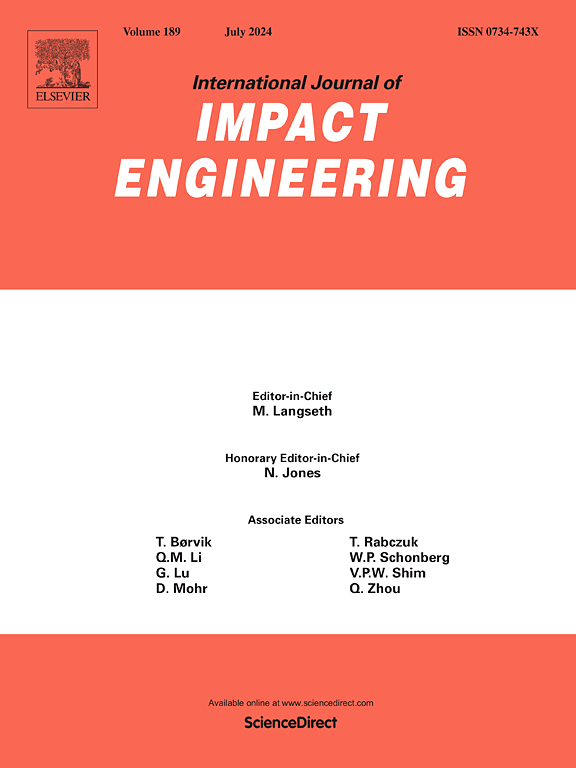Prediction of low-velocity impact responses for bio-inspired helicoidal laminates based on machine learning
IF 5.1
2区 工程技术
Q1 ENGINEERING, MECHANICAL
International Journal of Impact Engineering
Pub Date : 2024-10-11
DOI:10.1016/j.ijimpeng.2024.105144
引用次数: 0
Abstract
The inherent capacity of natural protective systems to withstand impact loadings, attributed to their microscale helicoidal architectures, has garnered significant interest. Drawing inspiration from this mechanically robust design, this study aims to introduce the composite laminates with a helicoidal distribution and to accurately and efficiently predict their Low-Velocity Impact (LVI) responses. Initially, the Latin hypercube design (LHS) was employed to generate 500 samples representing various pitch angles. An experimentally verified finite element model was then established to capture the load-displacement curves and energy-time curves for these 500 samples. Subsequently, the Convolutional Neural Network (CNN) model was utilized to accurately predict the load-displacement curves and energy-time curves for bio-inspired helicoidal laminates across different pitch angles. The principal component analysis (PCA) was used to enhance the efficiency of learning the load-displacement and energy-time curves in a reduced dimensional space, and the SHapley Additive exPlanations (SHAP) method was employed to investigate the feature importance of pitch angle. Finally, the helicoidal laminate with the highest energy absorption for a given volume was obtained by the genetic algorithm (GA) combined with the CNN model. This optimized laminate demonstrates a remarkable 9.5 % improvement in energy absorption compared to the best-performing sample within the original data set. Furthermore, the "spiraling" delamination damage of the helicoidal laminates was studied, which indicates that the delamination with small pitch angle is more pronounced for that with large pitch angle. The proposed method offers significant advantages in terms of cost reduction and efficiency enhancement for predicting the LVI responses of helicoidal laminates, holding immense potential in structural design and optimization of composite materials.
基于机器学习的生物启发螺旋形层压板低速冲击响应预测
天然防护系统因其微米级的螺旋结构而具有抵御冲击载荷的内在能力,这引起了人们的极大兴趣。本研究从这种机械坚固设计中汲取灵感,旨在引入具有螺旋分布的复合材料层压板,并准确有效地预测其低速冲击(LVI)响应。首先,采用拉丁超立方设计(LHS)生成 500 个代表不同俯仰角的样本。然后建立一个经过实验验证的有限元模型,以捕捉这 500 个样本的载荷-位移曲线和能量-时间曲线。随后,利用卷积神经网络(CNN)模型准确预测了不同螺距角的生物启发螺旋形层压板的载荷-位移曲线和能量-时间曲线。利用主成分分析法(PCA)提高了在降维空间中学习载荷-位移曲线和能量-时间曲线的效率,并采用 SHapley Additive exPlanations(SHAP)方法研究了螺距角特征的重要性。最后,通过遗传算法(GA)与 CNN 模型相结合,得到了在给定体积下能量吸收最高的螺旋形层压板。与原始数据集中表现最好的样本相比,这种优化层压板的能量吸收能力显著提高了 9.5%。此外,还研究了螺旋形层压板的 "螺旋 "分层损伤,结果表明,小螺距角的分层比大螺距角的分层更明显。所提出的方法在降低成本和提高效率方面具有显著优势,可用于预测螺旋形层压板的 LVI 响应,在复合材料的结构设计和优化方面具有巨大潜力。
本文章由计算机程序翻译,如有差异,请以英文原文为准。
求助全文
约1分钟内获得全文
求助全文
来源期刊

International Journal of Impact Engineering
工程技术-工程:机械
CiteScore
8.70
自引率
13.70%
发文量
241
审稿时长
52 days
期刊介绍:
The International Journal of Impact Engineering, established in 1983 publishes original research findings related to the response of structures, components and materials subjected to impact, blast and high-rate loading. Areas relevant to the journal encompass the following general topics and those associated with them:
-Behaviour and failure of structures and materials under impact and blast loading
-Systems for protection and absorption of impact and blast loading
-Terminal ballistics
-Dynamic behaviour and failure of materials including plasticity and fracture
-Stress waves
-Structural crashworthiness
-High-rate mechanical and forming processes
-Impact, blast and high-rate loading/measurement techniques and their applications
 求助内容:
求助内容: 应助结果提醒方式:
应助结果提醒方式:


